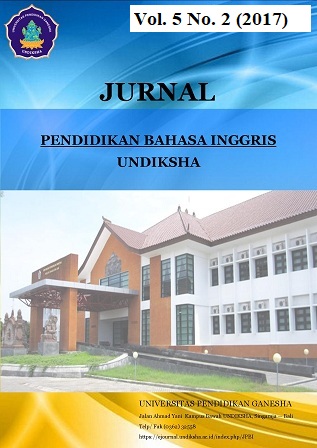AN ANALYSIS OF LANGUAGE FUNCTION AND EXPRESSION USED BY TOUR GUIDES AT BALI BEST MEMORY TOURS IN HANDLING TOURISTS
DOI:
https://doi.org/10.23887/jpbi.v5i2.12150Abstract
Penelitian ini bertujuan untuk menganalisis fungsi dan ungkapan bahasa yang digunakan oleh pemandu wisata di Bali Best Memory Tours dalam menangani wisatawan. Untuk mencapai tujuan ini, penelitian ini menggunakan penelitian kualitatif deskriptif, yang dilakukan dengan mengamati, merekam audio, dan mewawancarai subjek. Subjek penelitian ini adalah 2 pemandu wisata di Bali Best Memory Tours. Hasil penelitian menunjukkan bahwa ada 6 fungsi bahasa yang digunakan oleh pemandu wisata dalam menangani wisatawan, seperti: (1) fungsi untuk ucapan, (2) fungsi pemberian informasi, (3) fungsi untuk menawarkan sesuatu, (4). ) berfungsi untuk berterima kasih, (5) berfungsi untuk meminta maaf dan (6) berfungsi untuk mengucapkan selamat tinggal. Dari 6 fungsi bahasa, fungsi pemberian informasi banyak digunakan oleh pemandu wisata dalam menangani para wisatawan. Fungsi pemberian informasi sebanyak 58 kali (57%), kemudian dilanjutkan dengan fungsi untuk mengucapkan terima kasih sebanyak 11 kali (11%), berfungsi untuk menyapa 10 kali (10%), berfungsi untuk meminta maaf 9 kali (9%) dan berfungsi untuk menawarkan sesuatu 8 kali (8%). Fungsi bahasa yang paling sedikit yang digunakan oleh pemandu wisata adalah fungsi untuk mengucapkan selamat tinggal, yang muncul 5 kali (5%). Dalam mengekspresikan fungsi bahasa tersebut, pemandu wisata di Bali Best Memory Tours kebanyakan menggunakan ekspresi formal, yang digunakan 96% oleh kedua pemandu wisata. Dan ada 4% ekspresi informal yang digunakan oleh pemandu wisata dalam menangani para wisatawan.Kata Kunci : fungsi bahasa, ekspresi bahasa, pemandu wisata
This study aimed at analyzing language functions and expressions used by the tour guides at Bali Best Memory Tours in handling tourists. To accomplish this goal, this study used a descriptive qualitative research, which was conducted by observing, audio recording, and interviewing the subjects. The subjects of this study were 2 tour guides at Bali Best Memory Tours. The results of the study show that there were 6 language functions used by the tour guides in handling the tourists, such as: (1) function for greeting, (2) function for giving information, (3) function for offering something, (4) function for thanking, (5) function for apologizing and (6) function for saying goodbye. Out of 6 language functions, function for giving information was mostly used by the tour guides in handling the tourists. Function for giving information was used 58 times (57%), then followed by function for thanking that occurred 11 times (11%), function for greeting 10 times (10%), function for apologizing 9 times (9%) and function for offering something 8 times (8%). Moreover, the least language function that was used by the tour guides was the function for saying goodbye, occurring 5 times (5%). In expressing those language functions the tour guides at Bali Best Memory Tours mostly used formal expression, which were expressed 96% by both of the tour guides. Moreover, there were 4% informal expressions committed by the tour guides while handling the tourists.
keyword : language functions, language expressions, tour guides
Published
2017-10-25
Issue
Section
Articles
License
Authors who publish with the Jurnal Pendidikan Bahasa Inggris Undiksha agree to the following terms:- Authors retain copyright and grant the journal the right of first publication with the work simultaneously licensed under a Creative Commons Attribution License (CC BY-SA 4.0) that allows others to share the work with an acknowledgment of the work's authorship and initial publication in this journal
- Authors are able to enter into separate, additional contractual arrangements for the non-exclusive distribution of the journal's published version of the work (e.g., post it to an institutional repository or publish it in a book), with an acknowledgment of its initial publication in this journal.
- Authors are permitted and encouraged to post their work online (e.g., in institutional repositories or on their website) prior to and during the submission process, as it can lead to productive exchanges, as well as earlier and greater citation of published work. (See The Effect of Open Access)













